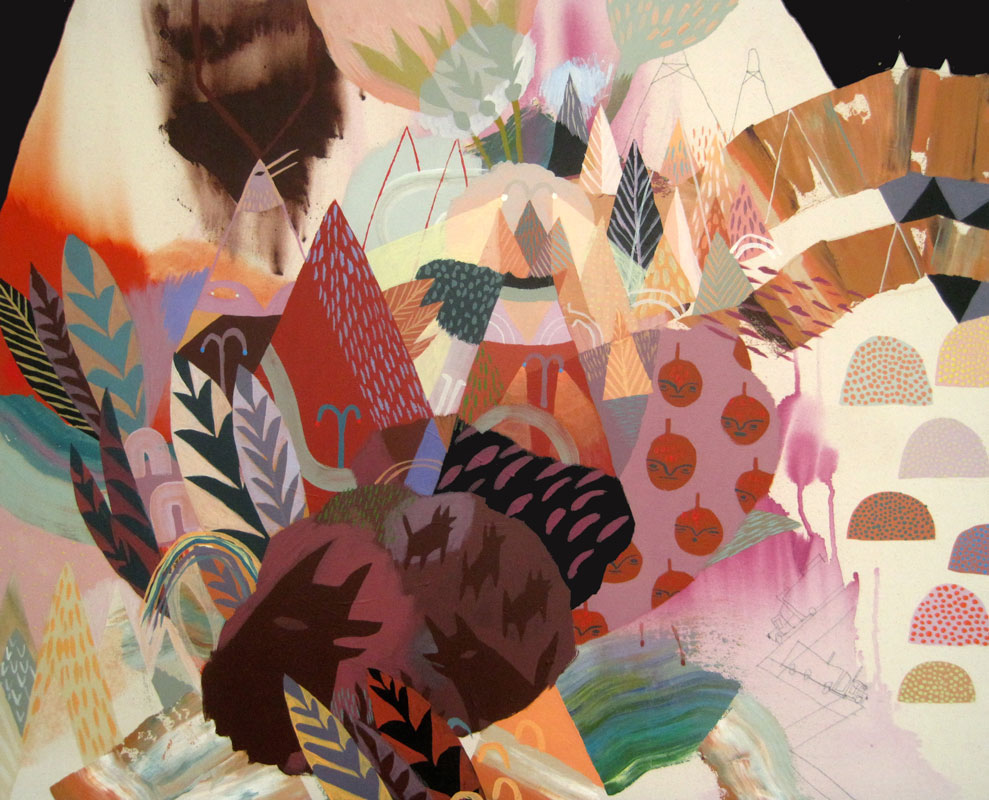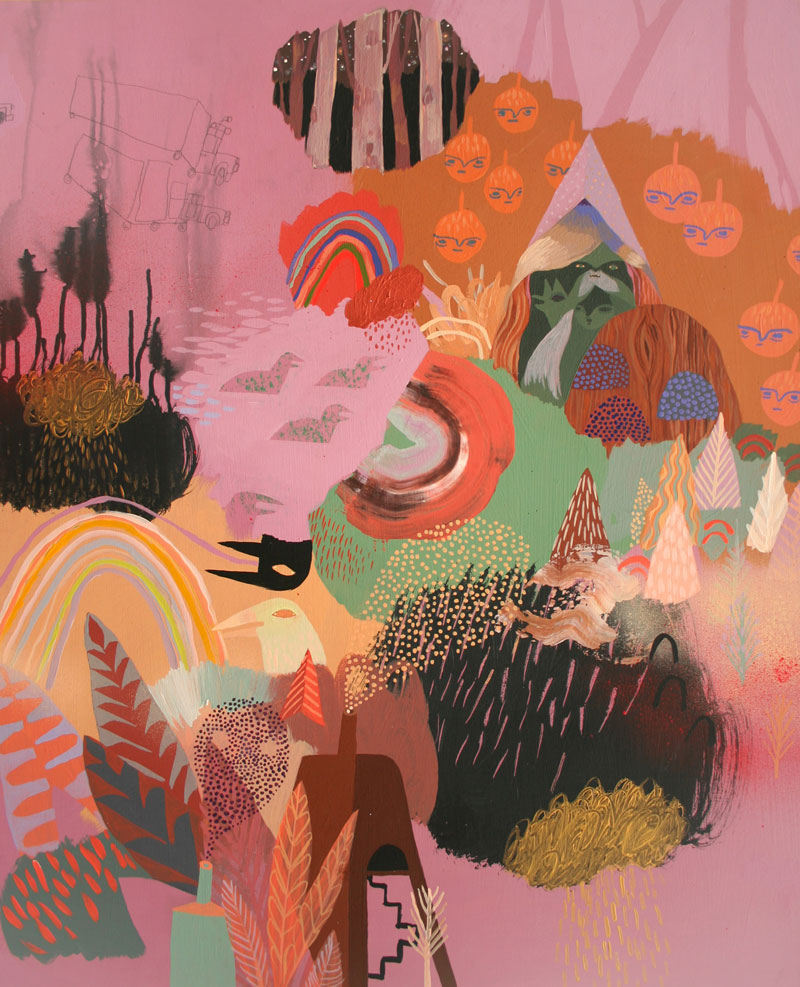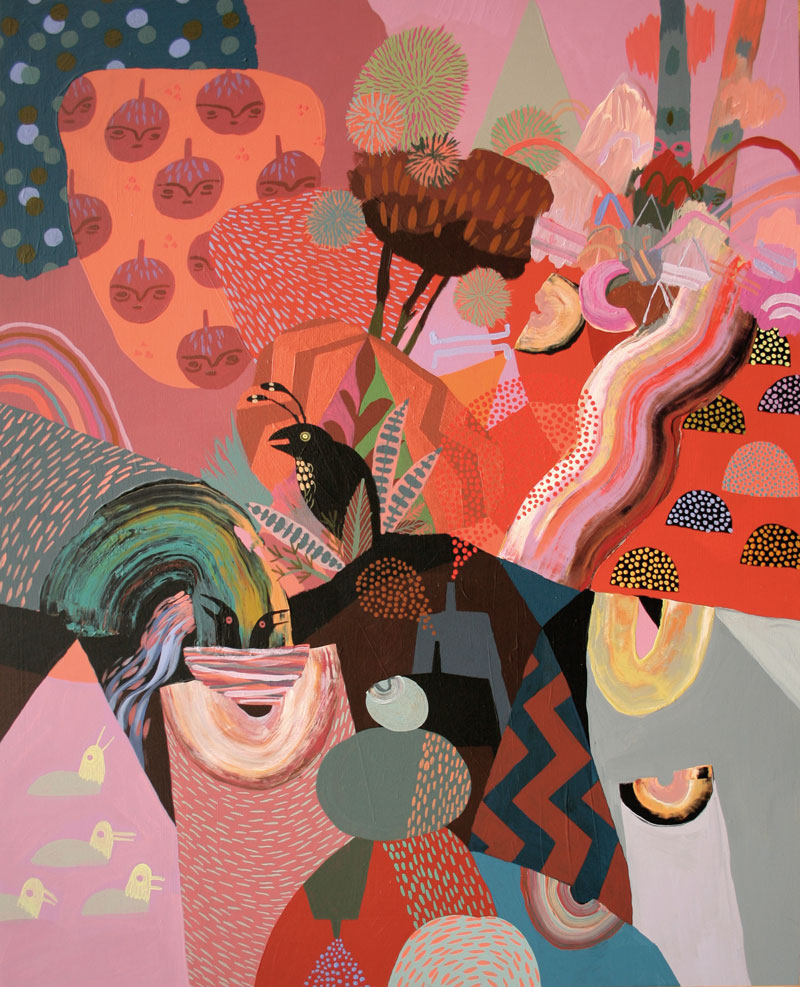Please select paintings to view. To view medium/size/location/availability on a desktop, hover over the image. On a device, use the white dot on the corner of the screen.
LORAFAUNA October 14-28, 2017. Madrona Gallery. Victoria.
opens Saturday October 14, 1-4 pm. 606 View Street
Lorafauna pays tribute to the marvels and mysteries of the coast and forest. Using animal and mythical motifs, symbolic landscape elements, and a highly tuned colour palette, these paintings portray the stories of dark and light just under the surface of familiar places. In addition to acrylic paintings, watercolours will be featured in series for the first time.
Essay by Laurie White from the catalogue Meghan Hildebrand:Lorafauna
The Forest at Night
The vibrant worlds of Meghan Hildebrand’s paintings are instantly captivating. Densely layered compositions create a sense of depth that invites a viewer to spend long moments investigating the scenery. Overflowing with colour and texture, her images draw their audience nearer, rewarding close looking with subtle details. The joyful palettes and painterly mark making for which Hildebrand has become well known continue to animate her artistic practice. In this new body of work, Hildebrand returns to a mode of painting in which chaotic energy is conveyed through a closer relationship with abstraction. Foreground an background seemingly interwoven, the works in Lorafauna give the viewer the sense of being lost within a jostling environment, replete with chirping wildlife and watchful trees.
One way to read Lorafauna is as a collection of nocturnes. While previous series appear to hover in a realm beyond the temporal confines of night and day, this collection sees Hildebrand focusing on those hours in which human power is weaker, allowing a host of other forces to emerge and take control. In this way, Hildebrand situates herself within a younger generation of Canadian landscape painters who counter a prevailing myth that wilderness is uninhabited. Additionally, Hildebrand incorporates the evidence of industry into her work and is unafraid to show the pollution of forests and waterways. Yet her view of these places as alive and enchanted still remains strong. This blending of environmental degradation with a magical sensibility is typical to her work and she deftly holds the two in balance without casting judgement. Understood in this light Lorafauna can be seen as the mapping of an imaginative terrain, the everyday places and journeys suffused with uncanny activity and a glimpse of otherworldy presences.
This exhibition sees Hildebrand achieve her effects through two distinct, medium specific approaches. Half of the works collected here are large scale acrylics, on canvas and on wood. In these works Hildebrand continues to develop her now familiar approach to bold colour palettes, complex compositions and painterly brushwork to show the lush forests and jagged mountains of British Columbia’s landscape. The second half of the exhibition is comprised of watercolour paintings, shown in series for the first time.
The artist uses the fluidity and immediacy of this medium to aptly describe the many bodies of water that define this coastal region. Despite numerous experiments in watercolour before now, Hildebrand here enlarges them, giving the medium more room to develop and revealing watercolour to be just as strong a medium as her acrylics.
As a collection, Lorafauna constitutes an important stage in Hildebrand’s oeuvre. The reconciliation of distinct styles, as well as the new forays into the potentials of watercolour, show Hildebrand to be an artist committed to the constant re-evaluation of her own practice. It is this sustained inquiry into the potential of forms to be flexible and reconfigured that has produced Lorafauna as a body of work at once instantly recognisable yet ever new and surprising.
Visual Ecologies
Over the course of her career, Meghan Hildebrand ha become well known for a style that blends representation with techniques of abstraction. Fields of colour are layered upon one another forming vibrant backgrounds. Upon this base is added a wealth of marks and symbols creating a rich tapestry of textures akin to a patchwork quilt of many fabrics. In recent work, clouds of dots can be seen hovering over these already complex surfaces, creating shimmering optical effects. In Felt So Nice, a curved form, seemingly composed of many threads, weaves around a tree trunk to create flickering visual vibrations. With these deceptively simple painterly techniques, Hildebrand’s works produce a haptic form of seeing wherein “sight discovers in itself a specific function of touch that is uniquely its own.” In this way, abstraction in Hildebrand’s work can be understood to extend beyond form alone, and into the realm of tactile sensation.
A similarly tactile effect is created by the close grouping of symbols, as in the foreground of "Black Bunting". Crosses, arcs and triangles are densely packed to form a variegated area difficult to visually process. Elsewhere, the triangular chevron motif is deployed to form mountain ranges, forests, and even campsites. Capable of being assembled in multiple variations, landmarks and the paths between them are in constant variation in these works. This flexibility of forms constitutes a shifting lexicon where meaning is always contextual and never reducible to any one sign. Hildebrand activates her viewer’s tendency to narrativise by using these symbols as hooks into th painting. She says of her work, “often my paintings become a version of the childhood dream of searching a familiar place, that is not itself, for something that is never revealed.” The viewer thus becomes akin to a reader moving through a fragmented text, appropriating bits and pieces to form their own interpretation of the image.
An equally important feature to consider in understanding how the work operates is the format of the series. Hildebrand produces identifiable bodies of work with clearly defined visual styles, to the extent that collections become entities in and of themselves. This allows the artist to set up relationships between works, forming a kind of ecology of images that resonate with one another. In this collection, a particular method of applying paint in a continuous scraping motion with the flat edge of a palette knife communicates a rawness that flows across multiple images. Of the various works which use this technique, Cache explores it the most fully and the artist layers many of these strokes with other angular forms. The effect is distinctly mineral, at once crystalline and sedimentary, and recalls the visceral landscapes left behind by glaciers. Having set up this visual characteristic in Cache, links are formed with the other works that utilise it and some of that earthy quality is conferred to pieces like Badger and Creeping Thyme. The work of representation is therefore distributed across the collection of images and demonstrates Hildebrand’s skill in crafting relationships both within and across works.
Unruly Landscapes
Meghan Hildebrand was raised in the northern city o Whitehorse, Yukon Territory by her mother, an artist, and her father, a miner. After completing her education at Kootenay School of Arts and the Nova Scotia College of Art and Design, Hildebrand and her husband relocated to the small town of Powell River, traditional territory of the Tla'amin First Nation, tucked away in a nook on the Salish Sea. Once a prominent mill town, Powell River is distinguished by the hulking Catalyst Paper Corporation on the town’s northern shore. Plumes of steam gently rise from the factory’s tall cooling towers, capping the town like fluffy signature. On all sides stretch blue and green vistas, the many lakes and inlets punctuating the verdant green forests.
This tension between wilderness and the stark forms of industrial infrastructure is a perennial theme in Hildebrand’s work. In Lorafauna this same concern persists, yet with a more subtle focus on the traces of human intervention, not just into landscape, but into natural rhythms and processes. In the watercolour works such as The Kinglet’s Regatta, BC’s logging industry is indicated through bald hillsides speckled with tree stumps after clear cutting. The harvested logs are seen on the ocean, waiting to be transported and processed. In another work, Awake and Listening, a red glow in the distance suggests a forest fire burning through the night. In 2017, long-term effects of the forestry industry, combined with years of suppression by settler societies, led to a record number of forest fires in BC, placing the province in a state of emergency. But while this year may have made the headlines, fires are an annual reality for BC’s rural residents and an ordinary part of the forest’s cycles of renewal. Hildebrand’s restrained representation of the fires signal both the realities of living in an economy based on natural resources and the power of natural processes to assert themselves, over and against human attempts to control them.
Other works also point to ecological disruption. In Tanglebound, an area of black paint in the upper left of the image bleeds across the painting’s surface next to the sketched outlines of two trucks, suggesting an oil spill from which the shapes of birds flee. Two tubular shapes in the upper right of Spruced Up recall pipelines and tank shaped furnaces release emission clouds throughout the series. The refusal to hide these aspects of the landscape and to show them imbricated in chains of effects (are those clouds of acid rain falling from the sky in Tanglebound?) shows the artist’s critical awareness of her surroundings and her commitment to processing that reality through her work. In Lorafauna, this awareness is grounded even further by the submersion of the viewer into a recognisable landscape. While earlier bodies of work may have taken up the theme of industry, they tended to show the effects as detached: floating worlds amid clouds. The new work by comparison is in and of the earth and shows a keen interest in the materiality of that earth, its forms and textures. A future utopic dreamworld is replaced with a turbulent present in all its complexities.
The Watchers
One of the most charming aspects of Meghan Hildebrand’s work is that her landscapes are inhabited a manifold of flora and fauna, some fantastical, others more familiar. It is this multispecies community that Hildebrand pays tribute to in her title, Lorafauna, a made-up word meaning something like “beautiful creatures.” More often than not these critters act as witnesses to the scenes in which they are implicated. A recurring motif in Lorafauna is the magical plant expressed as bushes full of grumpy looking fruit or chirpy root vegetables peeking out from behind tree trunks Hildebrand has noted that this image first began to appear in her work during a residency in Oaxaca, Mexico. After a visit to the Rufino Tamayo Museum of Pre-Hispanic Sculpture, she began to incorporate the enigmatic expressions of the faces she found there onto onion-like figures and rocks. Whether intentionally or not, these enchanted plants reference a long and diverse history of magical folk lore across continents. One such reference would be the ninmenju, a Japanese spirit or yokai that takes the form of a tree filled with head shaped fruit that laugh at passersby. These yokai are “undomesticated expressions of nature, denizens of a wild territory beyond human agency.” The viewer’s gaze is thus returned by the communities of plants, animals, and even landforms that inhabit the scene. In Chaperone, the very mountains themselves keep a watchful eye on the valley below. The warm tones of the painting further add to a sense of vitality, of the hills as living entities.
Hildebrand frequently presents animals in her works, her stylised forms having become a signature feature. But it is important to note that she also presents them in clusters. No lone wolves here but rather packs and collectives, flocks and herds. Moreover, the animals often appear to be in dialogue with one another, alluding to cooperation and communication. In Duck Lake Mainline, a quartet of ducks quack towards the hills, their expressions translated into language by the characteristic speech bubble. In the foothills, a pack of wolves bark back their dissent while a wizened mountain spirit looks on in amusement. This cacophony of voices challenges the conception of wilderness as uninhabited and grants agency to those who inhabit it. It is important to note that such a world view is not new to these lands. Indigenous peoples of the northwest coast have long held the understanding that the land, and the other-than-humans we share it with, are active participants in human endeavours, whether we like it or not. Hildebrand’s re-enchantment of the forests and seas is thus a playful yet necessary tool for reconfiguring relationships with the natural world.
A State of Flow
Bringing us ever closer to this enchanted realm is Hildebrand’s new collection of watercolour paintings, their softer tones and delicate layering suggestive of half-remembered dreams. In these works the perspective is kept low, close to the shoreline with its ebbs and flows, starry skies overhead. Boats cruise past one another, propelled by the tide, as flocks of waterfowl go about their business and ferry ports slip by. Hildebrand once again weaves a tapestry of possible narratives; the crossing ships elude our ability to know where they are going, or where they have been. A broken-down truck covered in pine needles, the residue of rural life, sinks into the earth suggesting projects forgotten or abandoned. As the title of Porchside implies, life on the coast has a different pace and more time is given over to simply watching the world turn.
One watercolour stands out from the rest. At more than twice the size of her other works on paper, this piece commands the same presence as any canvas. It is a wintry scene replete with icy crags and frozen pools. Nightcrowned Northern Shoveler deftly utilises negative space, the whiteness of the paper coming to represent a snowy land. The effect is spartan, slightly chilly, but conveys a monumentality to the northern landscape that Hildebrand expresses more clearly in this piece than any other. Like a foot in the door, this work holds open the possibility of further exploration into visual languages and imaginative terrains as yet uncharted by Hildebrand’s existing work. It shows the artist’s unrelenting commitment to experimentation while testing the limits of her existing lexicon. As her approach to the tricky subjects of ecological degradation, multispecies cooperation, and the unique identity of place continue to develop it is this creative energy that will continue to distinguish Meghan Hildebrand as an innovative and exciting artist in the field o contemporary painting.
Notes
1 See John O’Brian and Peter White, Beyond Wilderness: The Group of Seven, Canadian Identity and Contemporary Art, (Montreal: McGill-Queen’s University Press, 2007).
2 Gilles Deleuze, Francis Bacon: the logic of sensation, trans. Daniel W. Smith, (London: Continum, 2003), 150.
3 Meghan Hildebrand, “Artist Statement,” http://yukonartscentre.com/calendar/ event/meghan_hildebrand_look_at_the_things_weve_found/
4 Michael Dylan Foster, The Book of Yokai, (Oakland, CA: University of California Press, 2015), 115. The medieval European example of mandrakes would be another compelling example.
5 Kim Tallbear “Beyond Life/Not Life: A Feminist Indigenous Reading of Cryopreservation, Interspecies Thinking, and the New Materialisms” (keynote address, University of Texas at Austin, February 2015), https:// www.youtube.com/watch?v=iE-gaDG-kLQ


















